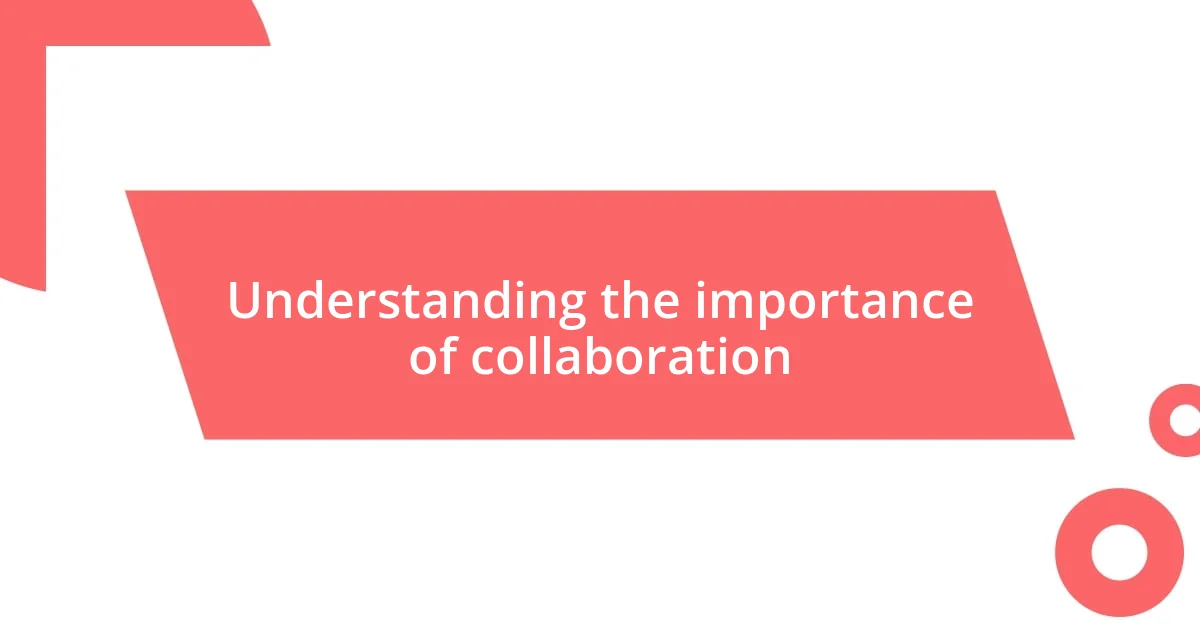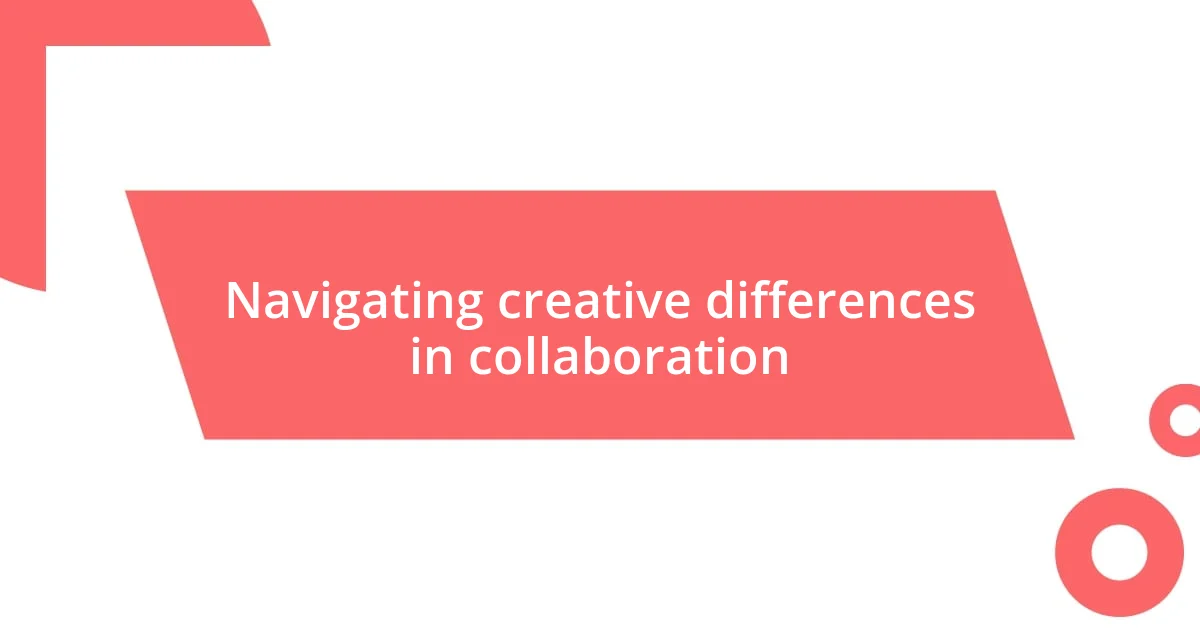Key takeaways:
- Collaboration enriches artistic work by bringing diverse perspectives and cultivating a sense of community.
- Setting clear goals and establishing shared responsibilities enhance communication and accountability within the collaboration process.
- Effective evaluation of collaborations includes assessing both the creative journey and the lasting impact on future projects, emphasizing emotional satisfaction and learning.

Understanding the importance of collaboration
Collaboration opens the door to diverse perspectives and ideas that can enrich an artist’s work in ways they might not have imagined. I remember working on a project where my co-creator brought in their unique style; it completely shifted my approach to the piece. Have you ever experienced a moment where someone else’s insight illuminated a path you hadn’t considered?
It’s fascinating how blending different talents can lead to unexpected outcomes. On one occasion, I teamed up with a musician where our conversations flowed between art forms, and the synergy sparked creativity I hadn’t tapped into alone. This reminds me—could it be that sometimes we limit ourselves by working in isolation?
When you collaborate, you also cultivate a sense of community that can be incredibly fulfilling. I’ve found that sharing triumphs and challenges with fellow artists fosters deeper connections and mutual support. Isn’t it amazing how collaboration can transform loneliness into a shared journey toward artistic growth?

Setting clear goals for collaboration
When embarking on a collaboration, I believe it’s essential to set clear goals from the outset. This clarity helps streamline communication and ensures everyone is on the same page. I’ve found that when my collaborators and I define our objectives early on, it minimizes confusion and inspires more focused creativity.
Setting goals not only aligns efforts but also fosters accountability. I remember a project where we outlined our expected outcomes and timelines, which turned out to be invaluable. It kept us motivated and allowed us to celebrate small victories along the way, reinforcing our commitment to the artistic journey together. Have you ever noticed how following a roadmap can make the creative process feel less daunting?
In addition, having specific goals can also guide the direction of the project. For instance, during a mural collaboration, we set our sights on themes and styles that reflected our individual backgrounds. This framework enabled us to merge our visions harmoniously, resulting in a piece that truly represented both of us. Isn’t it interesting how a bit of structure can lead to more organic creativity?
| Goal Setting Aspect | Impact on Collaboration |
|---|---|
| Clarity | Reduces confusion and aligns efforts |
| Accountability | Encourages commitment and shared responsibility |

Effective communication strategies for collaboration
When it comes to effective communication strategies, I’ve found that active listening is key. It’s more than just hearing words; it’s about fully engaging with what the other artist is sharing. A few collaborations ago, my partner suggested ideas that felt completely outside my comfort zone. Instead of dismissing them, I took the time to truly understand their perspective, which not only deepened our connection but also led to a richer final piece. Have you ever realized how much more creativity flows when you genuinely listen?
- Be present: Focus on the conversation without distractions.
- Ask clarifying questions: This shows your engagement and helps deepen understanding.
- Share your thoughts: Express your ideas openly, encouraging a two-way dialogue.
Another powerful strategy is utilizing visual aids to bridge communication gaps. I still remember a particularly complex project where we were struggling to find common ground on the design elements. By sketching out our ideas side by side, we transformed vague concepts into tangible visuals. It was like flipping a switch—suddenly, everything clicked! This experience highlighted for me how much more impactful visual communication can be, especially in a creative context.
- Use sketches or mood boards: These can provide a visual reference that speaks louder than words.
- Incorporate digital tools: Platforms like shared documents or design software can facilitate collaboration.
- Be open to feedback: Visual aids should evolve through collaborative input, reflecting a shared vision.

Navigating creative differences in collaboration
Navigating creative differences can be a real challenge in collaboration, but I’ve learned that embracing those differences often leads to unexpected gems. In one of my earlier partnerships, we had a significant clash over color choices. I felt strongly about using vibrant shades, while my collaborator preferred muted tones. Initially, it seemed like an impasse, but through honest discussion and compromise, we discovered a unique palette that blended both visions beautifully. This situation taught me that friction can spark innovation—have you ever found yourself in a similar spot?
I’ve also found that addressing creative differences requires a level of vulnerability. Sharing my authentic thoughts, even when they diverged from the group consensus, opened the door for others to voice their hesitations as well. I remember a time when I hesitated to express my dislike for a proposed concept, fearing it would create tension. Instead, I chose to share my feelings, and surprisingly, it encouraged my fellow artists to do the same. That moment of honesty shifted our entire dynamic, transforming a potential conflict into a collaborative dialogue that enriched our final product.
Sometimes, it’s beneficial to take a step back and reflect on the bigger picture. When we get lost in disagreements, I think it’s crucial to return to our shared goals. During a recent collaborative music project, we hit a wall over the direction of a particular song. Instead of pushing through the tension, we paused to revisit our original intentions. This reset not only clarified our focus but also reminded us of the passion that brought us together. Have you ever taken a breather in the midst of creative chaos? It can lead to a profound renewal of creative energy.

Managing shared responsibilities in projects
Sharing responsibilities in collaborative projects can be tricky, yet I’ve discovered it can also be incredibly rewarding. In one project, my partner and I split the workload based on our strengths. I took on the logistics while they focused on the creative aspects. This division not only lessened the stress but allowed us to shine in our own areas of expertise. Have you ever noticed how a well-defined role can enhance teamwork?
I remember a time when we missed deadlines because we were unclear about our individual responsibilities. It was a wake-up call—soon after, we established a shared calendar and regular check-ins. I found that setting clear expectations upfront positively impacted our collaboration. It helped us stay accountable, turning chaos into a synchronized effort. How do you keep track of tasks when working with others, and do you find it effective?
To keep the momentum going, I believe it’s essential to celebrate milestones together. During a recent art exhibit project, every time we reached a goal, we took a moment to acknowledge it, big or small. This practice didn’t just lift our spirits; it fostered a sense of camaraderie and reinforced our shared commitment. It’s amazing how simple recognition can energize a team. How do you think celebrating achievements affects your collaborative experience?

Evaluating the success of collaborations
Evaluating the success of collaborations often involves reflecting on both the creative process and the final outcome. In one memorable project, after we completed a mural together, we gathered to discuss our experience. While we all praised the finished piece, it was the heartfelt conversations about what each of us learned that truly highlighted our success. Have you ever evaluated a project only to realize the journey mattered just as much, if not more, than the end result?
I find it essential to assess not just the visual or auditory outcome, but also the emotional satisfaction of each contributor. During a video project, we faced numerous hurdles, and by the end, some of us felt drained while others thrived. This disparity prompted an open dialogue, revealing that while the visuals were stunning, not everyone felt heard during the creative process. Isn’t it fascinating how a project’s success can vary among team members based on their experience?
Another critical factor for me is the lasting impact of a collaboration. After finishing a music track, I noticed that my collaboration partner and I continued to draw inspiration from our work for future projects. This ongoing influence felt like a true marker of success, as it showed that our creative synergy had sparked new ideas and directions. Have you ever felt that a collaboration extended beyond its initial boundaries, shaping your future work in unexpected ways?















